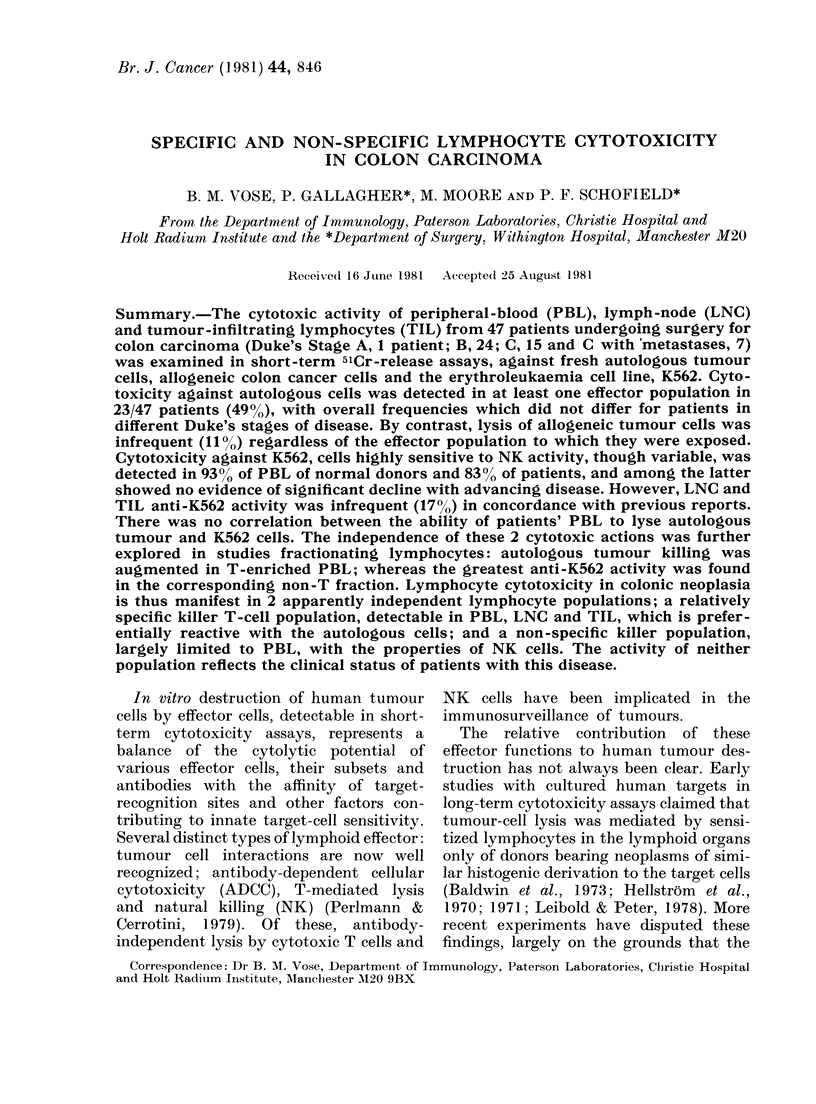Specific and non-specific lymphocyte cytotoxicity in colon carcinoma (original) (raw)
Abstract
The cytotoxic activity of peripheral-blood (PBL), lymph-node (LNC) and tumour-infiltrating lymphocytes (TIL) from 47 patients undergoing surgery for colon carcinoma (Duke's Stage A, 1 patient; B, 24; C, 15 and C with metastases, 7) was examined in short-term 51Cr-release assays, against fresh autologous tumour cells, allogeneic colon cancer cells and the erythroleukaemia cell line, K562. Cytotoxicity against autologous cells was detected in at least one effector population in 23/47 patients (49%), with overall frequencies which did not differ for patients in different Duke's stages of disease. By contrast, lysis of allogeneic tumour cells was infrequent (11%) regardless of the effector population to which they were exposed. Cytotoxicity against K562, cells highly sensitive to NK activity, though variable, was detected in 93% of PBL of normal donors and 83% of patients, and among the latter showed no evidence of significant decline with advancing disease. However, LNC and TIL anti-K562 activity was infrequent (17%) in concordance with previous reports. There was no correlation between the ability of patients' PBL to lyse autologous tumour and K562 cells. The independence of these 2 cytotoxic actions was further explored in studies fractionating lymphocytes: autologous tumour killing was augmented in T-enriched PBL; whereas the greatest anti-K562 activity was found in the corresponding non-T fraction. Lymphocyte cytotoxicity in colonic neoplasia is thus manifest in 2 apparently independent lymphocyte populations; a relatively specific killer T-cell population, detectable in PBL, LNC and TIL, which is preferentially reactive with the autologous cells; and a non-specific killer population, largely limited to PBL, with the properties of NK cells. The activity of neither population reflects the clinical status of patients with this disease.

Selected References
These references are in PubMed. This may not be the complete list of references from this article.
- Bakacs T., Klein E., Ljungström K. G. Search for disease-related cytotoxicity in mammary tumor patients. Cancer Lett. 1978 Apr;4(4):191–197. doi: 10.1016/s0304-3835(78)94402-6. [DOI] [PubMed] [Google Scholar]
- Becker S., Kiessling R., Lee N., Klein G. Modulation of sensitivity to natural killer cell lysis after in vitro explantation of a mouse lymphoma. J Natl Cancer Inst. 1978 Dec;61(6):1495–1498. [PubMed] [Google Scholar]
- Emeson E. E. Migratory behavior of lymphocytes with specific reactivity to alloantigens. II. Selective recruitment to lymphoid cell allografts and their draining lymph nodes. J Exp Med. 1978 Jan 1;147(1):13–24. doi: 10.1084/jem.147.1.13. [DOI] [PMC free article] [PubMed] [Google Scholar]
- Eremin O., Coombs R. R., Plumb D., Ashby J. Characterization of the human natural killer (NK) cell in blood and lymphoid organs. Int J Cancer. 1978 Jan 15;21(1):42–50. doi: 10.1002/ijc.2910210109. [DOI] [PubMed] [Google Scholar]
- Herberman R. B., Holden H. T. Natural cell-mediated immunity. Adv Cancer Res. 1978;27:305–377. doi: 10.1016/s0065-230x(08)60936-7. [DOI] [PubMed] [Google Scholar]
- Jondal M., Holm G., Wigzell H. Surface markers on human T and B lymphocytes. I. A large population of lymphocytes forming nonimmune rosettes with sheep red blood cells. J Exp Med. 1972 Aug 1;136(2):207–215. doi: 10.1084/jem.136.2.207. [DOI] [PMC free article] [PubMed] [Google Scholar]
- Julius M. H., Simpson E., Herzenberg L. A. A rapid method for the isolation of functional thymus-derived murine lymphocytes. Eur J Immunol. 1973 Oct;3(10):645–649. doi: 10.1002/eji.1830031011. [DOI] [PubMed] [Google Scholar]
- Lozzio C. B., Lozzio B. B. Cytotoxicity of a factor isolated from human spleen. J Natl Cancer Inst. 1973 Feb;50(2):535–538. doi: 10.1093/jnci/50.2.535. [DOI] [PubMed] [Google Scholar]
- Nairn R. C., Nind A. P., Guli E. P., Davies D. J., Rolland J. M., McGiven A. R., Hughes E. S. Immunological reactivity in patients with carcinoma of colon. Br Med J. 1971 Dec 18;4(5789):706–709. doi: 10.1136/bmj.4.5789.706. [DOI] [PMC free article] [PubMed] [Google Scholar]
- Pihl E., Nairn R. C., Nind A. P., Muller H. K., Hughes E. S., Cuthbertson A. M., Rollo A. J. Correlation of regional lymph node in vitro antitumor immunoreactivity histology with colorectal carcinoma. Cancer Res. 1976 Oct;36(10):3665–3671. [PubMed] [Google Scholar]
- Pross H. F., Baines M. G. Spontaneous human lymphocyte-mediated cytotoxicity againts tumour target cells. I. The effect of malignant disease. Int J Cancer. 1976 Nov 15;18(5):593–604. doi: 10.1002/ijc.2910180508. [DOI] [PubMed] [Google Scholar]
- Takasugi M., Mickey M. R., Terasaki P. I. Reactivity of lymphocytes from normal persons on cultured tumor cells. Cancer Res. 1973 Nov;33(11):2898–2902. [PubMed] [Google Scholar]
- Timonen T., Ortaldo J. R., Herberman R. B. Characteristics of human large granular lymphocytes and relationship to natural killer and K cells. J Exp Med. 1981 Mar 1;153(3):569–582. doi: 10.1084/jem.153.3.569. [DOI] [PMC free article] [PubMed] [Google Scholar]
- Vose B. M., Moore M. Natural cytotoxicity in humans: susceptibility of freshly isolatd tumor cells to lysis. J Natl Cancer Inst. 1980 Aug;65(2):257–263. [PubMed] [Google Scholar]
- Vose B. M., Moore M., Schofield P. F., Dymock I. W. Leucocytotoxicity in malignant and non-malignant colonic diseases. Clin Exp Immunol. 1975 Dec;22(3):393–398. [PMC free article] [PubMed] [Google Scholar]
- Vose B. M., Moore M. Suppressor cell activity of lymphocytes infiltrating human lung and breast tumours. Int J Cancer. 1979 Nov 15;24(5):579–585. doi: 10.1002/ijc.2910240510. [DOI] [PubMed] [Google Scholar]
- Werkmeister J. A., Pihl E., Nind A. P., Flannery G. R., Nairn R. C. Immunoreactivity by intrinsic lymphoid cells in colorectal carcinoma. Br J Cancer. 1979 Dec;40(6):839–847. doi: 10.1038/bjc.1979.274. [DOI] [PMC free article] [PubMed] [Google Scholar]